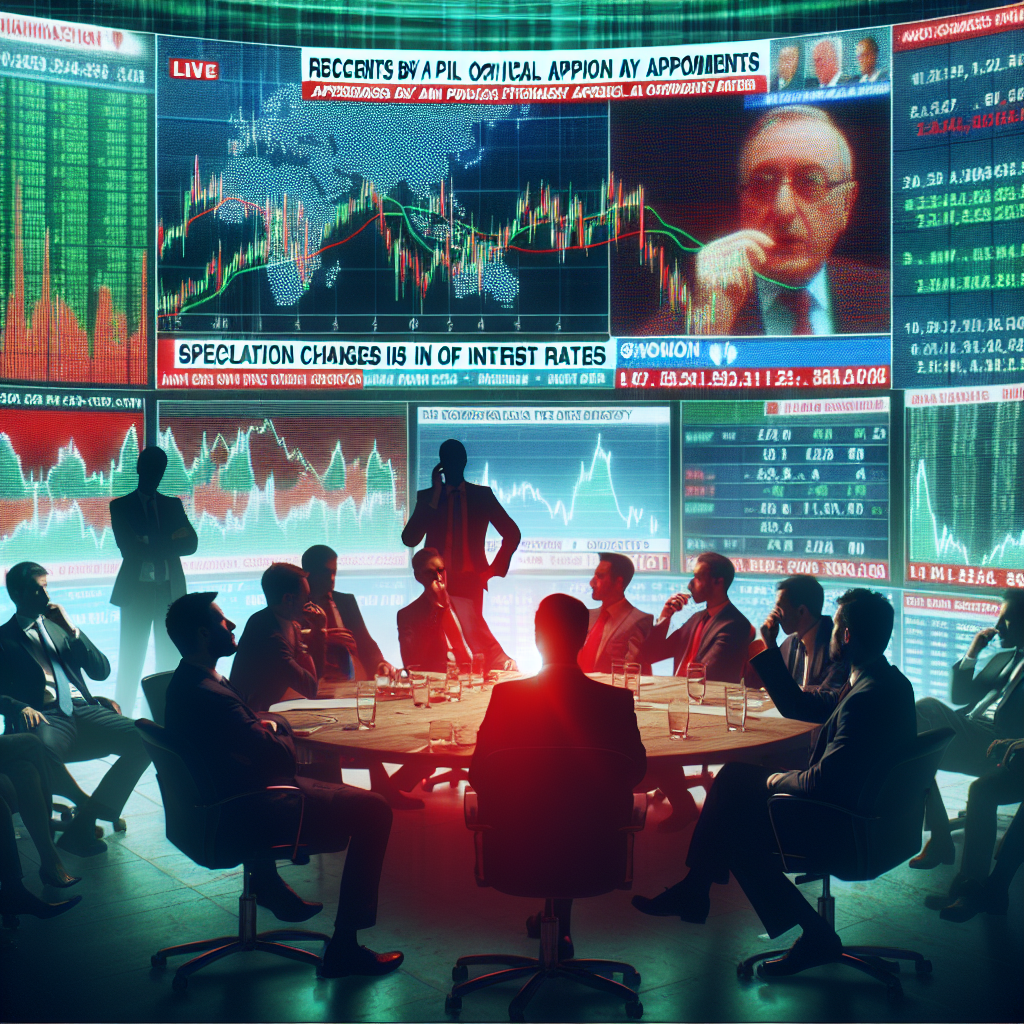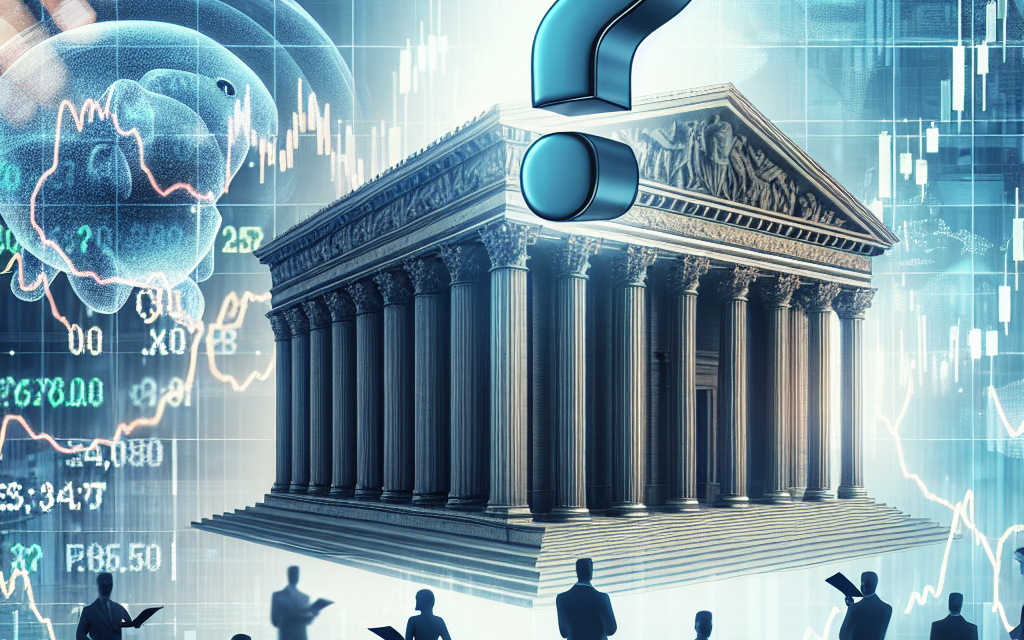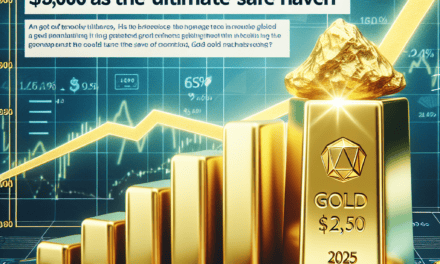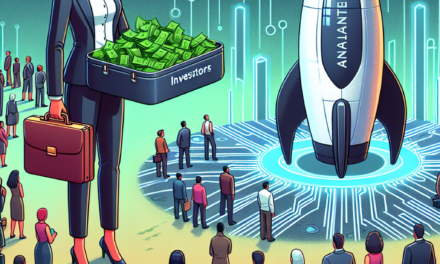“Navigating the Unknown: Trump Appointments and Interest Rate Speculation Shake Markets”
Introduction
In recent times, financial markets have been navigating a landscape marked by uncertainty, driven by the dual forces of political appointments and monetary policy speculation. The appointment of key figures by former President Donald Trump has introduced a new dynamic to the economic environment, influencing investor sentiment and market trajectories. Concurrently, speculation surrounding potential interest rate adjustments by central banks has added another layer of complexity, as market participants weigh the implications of monetary policy shifts on economic growth and investment strategies. This confluence of political and economic factors has created a climate of unpredictability, prompting investors to reassess risk and recalibrate their portfolios in response to evolving conditions.
Impact Of Trump Appointments On Global Markets
The global markets have been experiencing a period of uncertainty, largely influenced by recent appointments made by former President Donald Trump and ongoing speculation regarding interest rate adjustments. These developments have created a complex landscape for investors, who are now navigating a myriad of factors that could potentially impact their portfolios. As the world watches closely, the interplay between political decisions and economic indicators continues to shape market dynamics.
To begin with, the appointments made by Trump during his presidency have had a lasting impact on both domestic and international markets. His choices for key positions, such as the Federal Reserve Chair and other economic advisors, have influenced monetary policy and regulatory frameworks. These appointments often signaled shifts in economic priorities, which in turn affected investor confidence and market stability. For instance, the appointment of individuals with a more hawkish stance on interest rates could lead to expectations of tighter monetary policy, thereby influencing bond yields and equity valuations.
Moreover, Trump’s appointments extended beyond economic roles, affecting trade policies and international relations. His administration’s approach to trade agreements and tariffs introduced a level of unpredictability that reverberated through global markets. Countries reliant on trade with the United States found themselves recalibrating their economic strategies, while businesses faced new challenges in supply chain management and cost structures. Consequently, these geopolitical shifts contributed to market volatility, as investors sought to anticipate the long-term implications of such policies.
In addition to the impact of Trump’s appointments, speculation surrounding interest rate changes has further compounded market uncertainty. Central banks around the world, including the Federal Reserve, have been closely monitoring economic indicators to determine the appropriate timing and magnitude of interest rate adjustments. The prospect of rising interest rates often leads to a reassessment of asset valuations, as higher rates can increase borrowing costs and reduce corporate profits. This, in turn, affects stock prices and investor sentiment.
Furthermore, the anticipation of interest rate hikes can lead to capital flows between markets, as investors seek higher returns in different regions. This movement of capital can result in currency fluctuations, adding another layer of complexity to the global economic environment. Emerging markets, in particular, may experience heightened vulnerability, as changes in interest rates in developed economies can lead to capital outflows and increased borrowing costs.
As these factors converge, market participants are left grappling with a challenging landscape. The interplay between political appointments and interest rate speculation underscores the interconnectedness of global markets, where decisions made in one part of the world can have far-reaching consequences. Investors are now tasked with balancing short-term volatility against long-term growth prospects, all while remaining vigilant to the evolving economic and political landscape.
In conclusion, the uncertainty in global markets, driven by Trump’s appointments and interest rate speculation, highlights the intricate relationship between political decisions and economic outcomes. As investors navigate this complex environment, they must remain attuned to the myriad factors influencing market dynamics. By understanding the potential impacts of these developments, market participants can better position themselves to manage risk and capitalize on opportunities in an ever-changing global economy.
Interest Rate Speculation: What Investors Need To Know
In recent months, the financial markets have been characterized by a notable degree of uncertainty, primarily driven by two significant factors: the appointments made by former President Donald Trump and ongoing speculation regarding interest rate adjustments. Investors, who are always on the lookout for indicators that could influence market dynamics, find themselves navigating a complex landscape where political decisions and monetary policy are intricately intertwined.
To begin with, the appointments made by Trump have introduced a layer of unpredictability into the markets. These appointments, often marked by their unconventional nature, have the potential to shift policy directions in ways that are not always immediately apparent. For instance, the selection of key figures in economic and financial roles can signal changes in regulatory approaches, fiscal policies, and international trade stances. Investors, therefore, must remain vigilant, analyzing how these appointments might influence economic growth, corporate profitability, and overall market sentiment.
Simultaneously, speculation surrounding interest rate changes continues to be a focal point for investors. Central banks, particularly the Federal Reserve, play a pivotal role in shaping economic conditions through their monetary policy decisions. Interest rates, which influence borrowing costs, consumer spending, and business investment, are a critical tool in managing economic stability. In periods of economic uncertainty, the anticipation of interest rate hikes or cuts can lead to significant market volatility. Investors are keenly aware that even the slightest hint of a rate change can trigger substantial shifts in asset prices, making it imperative to stay informed about central bank communications and economic indicators.
Moreover, the interplay between Trump’s appointments and interest rate speculation adds another layer of complexity. For instance, if a newly appointed official advocates for policies that could spur economic growth, such as tax cuts or deregulation, this might lead to expectations of inflationary pressures. In response, central banks might consider raising interest rates to curb potential inflation, thereby affecting market dynamics. Conversely, appointments that signal a more cautious approach to economic expansion could lead to expectations of prolonged low interest rates, influencing investment strategies accordingly.
In this context, investors must adopt a multifaceted approach to market analysis. It is essential to consider not only the direct implications of political appointments and interest rate decisions but also their broader impact on global economic trends. For example, changes in U.S. interest rates can have ripple effects across international markets, influencing currency valuations, capital flows, and trade balances. As such, a comprehensive understanding of both domestic and international economic indicators is crucial for making informed investment decisions.
Furthermore, it is important for investors to remain adaptable in the face of uncertainty. Diversification, a fundamental principle of investment strategy, becomes even more critical during times of market volatility. By spreading investments across various asset classes and geographic regions, investors can mitigate risks associated with sudden market shifts. Additionally, maintaining a long-term perspective can help investors weather short-term fluctuations and focus on achieving their financial goals.
In conclusion, the current market environment, shaped by Trump’s appointments and interest rate speculation, presents both challenges and opportunities for investors. By staying informed, analyzing the potential impacts of political and monetary developments, and adopting a diversified investment approach, investors can navigate this uncertain landscape with greater confidence. As the situation continues to evolve, remaining vigilant and adaptable will be key to successfully managing investment portfolios in the face of ongoing market uncertainties.
Navigating Market Uncertainty In The Trump Era
In the ever-evolving landscape of global finance, market participants find themselves navigating a complex web of uncertainty, particularly in the wake of recent appointments by former President Donald Trump and ongoing speculation regarding interest rate adjustments. The interplay between political decisions and economic indicators has always been a delicate balance, and the current climate is no exception. As investors and analysts attempt to decipher the implications of these developments, it becomes increasingly important to understand the underlying factors at play.
To begin with, the appointments made by Trump during his tenure have left a lasting impact on both domestic and international markets. His choices for key positions, such as those within the Federal Reserve and other regulatory bodies, have often been characterized by a preference for deregulation and a pro-business stance. This approach, while appealing to certain sectors, has also introduced a degree of unpredictability. Market participants are keenly aware that shifts in regulatory frameworks can have profound effects on market dynamics, influencing everything from corporate earnings to consumer confidence.
Simultaneously, the specter of interest rate changes looms large over the financial landscape. The Federal Reserve’s monetary policy decisions are closely watched, as they have the power to either stimulate or cool economic activity. Speculation about potential rate hikes or cuts can lead to volatility, as investors adjust their portfolios in anticipation of these moves. In this context, the Fed’s communication strategy becomes crucial. Clear and consistent messaging can help mitigate uncertainty, providing market participants with a better understanding of the central bank’s intentions and the economic rationale behind them.
Moreover, the global nature of today’s markets means that domestic decisions are rarely contained within national borders. Trump’s appointments and the Fed’s interest rate policies have ripple effects that extend far beyond the United States. International investors, for instance, must consider how these factors might influence currency exchange rates, trade balances, and cross-border capital flows. In an interconnected world, the actions of one nation can have significant repercussions for others, underscoring the importance of a comprehensive approach to market analysis.
In light of these complexities, investors are increasingly turning to diversification as a strategy to manage risk. By spreading investments across a range of asset classes and geographic regions, they aim to mitigate the impact of any single event or decision. This approach, while not foolproof, offers a measure of protection against the inherent uncertainties of the market. Additionally, the use of advanced analytical tools and data-driven insights is becoming more prevalent, enabling investors to make more informed decisions in an environment characterized by rapid change.
Ultimately, navigating market uncertainty in the Trump era requires a nuanced understanding of both political and economic factors. While the former president’s appointments and the ongoing interest rate speculation present challenges, they also offer opportunities for those willing to adapt and innovate. By staying informed and maintaining a flexible approach, market participants can better position themselves to capitalize on emerging trends and weather potential storms. As the financial landscape continues to evolve, the ability to anticipate and respond to change will remain a critical skill for investors and analysts alike.
How Political Appointments Influence Economic Policy

The intricate relationship between political appointments and economic policy is a subject of perennial interest, particularly in times of political transition. The recent appointments by former President Donald Trump have once again brought this dynamic to the forefront, as markets grapple with the implications of these decisions. Political appointments, especially those in key economic positions, can significantly influence the direction of economic policy, thereby affecting market stability and investor confidence. As such, understanding the potential impact of these appointments is crucial for stakeholders across the economic spectrum.
Political appointees often bring with them a set of ideologies and policy preferences that can shape the economic landscape. For instance, appointments to the Federal Reserve or the Treasury Department can have profound implications for monetary policy, fiscal policy, and regulatory frameworks. These individuals are tasked with making decisions that can influence interest rates, inflation, and overall economic growth. Consequently, markets tend to react to these appointments, as investors attempt to anticipate the future policy direction and adjust their strategies accordingly.
In the case of Trump’s recent appointments, there is a palpable sense of uncertainty in the markets. This uncertainty is compounded by ongoing speculation about potential changes in interest rates. The Federal Reserve’s interest rate decisions are a critical component of economic policy, as they influence borrowing costs, consumer spending, and business investment. Any indication of a shift in interest rate policy can lead to significant market volatility, as investors recalibrate their expectations and portfolios.
Moreover, the interplay between political appointments and interest rate speculation creates a complex environment for market participants. On one hand, political appointees may advocate for policies that align with their ideological leanings, potentially leading to changes in regulatory or fiscal policy. On the other hand, the Federal Reserve operates with a degree of independence, focusing on economic indicators to guide its interest rate decisions. This duality can create tension, as markets attempt to reconcile political influences with economic realities.
In addition to the direct impact on economic policy, political appointments can also affect market sentiment. The perception of stability and predictability is crucial for investor confidence, and any perceived instability can lead to market fluctuations. For example, if an appointee is seen as controversial or lacking in experience, it may lead to concerns about their ability to effectively manage economic policy, thereby increasing market uncertainty.
Furthermore, the global nature of today’s economy means that political appointments in one country can have ripple effects across international markets. Investors around the world closely monitor U.S. political developments, given the country’s significant influence on global economic trends. As such, Trump’s appointments are not only a domestic concern but also a matter of international interest.
In conclusion, political appointments play a pivotal role in shaping economic policy and influencing market dynamics. The recent appointments by Donald Trump, coupled with ongoing interest rate speculation, have created an environment of uncertainty that requires careful navigation by market participants. As political and economic landscapes continue to evolve, understanding the implications of these appointments remains essential for anticipating future market trends and making informed investment decisions.
The Role Of Central Banks Amid Interest Rate Speculation
In recent months, financial markets have been characterized by a notable degree of uncertainty, driven in part by the appointments made by former President Donald Trump and ongoing speculation regarding interest rate adjustments. Central banks, as pivotal institutions in the global financial system, play a crucial role in navigating these turbulent waters. Their actions, or sometimes the mere anticipation of their actions, can significantly influence market dynamics, investor sentiment, and economic stability.
Central banks, such as the Federal Reserve in the United States, the European Central Bank, and the Bank of England, are tasked with the dual mandate of fostering economic growth while maintaining price stability. In the context of interest rate speculation, their role becomes even more pronounced. Interest rates are a primary tool used by central banks to control inflation and stimulate or cool down economic activity. When markets anticipate a change in interest rates, it can lead to shifts in investment strategies, currency valuations, and overall market confidence.
The appointments made by Donald Trump during his presidency have added another layer of complexity to the current economic landscape. His choices for key positions, including those within the Federal Reserve, have been scrutinized for their potential impact on monetary policy. These appointments can influence the direction of interest rate policies, as the individuals in these roles bring their own perspectives and priorities to the table. Consequently, markets remain on edge, trying to decipher how these appointments might sway future policy decisions.
Amid this backdrop, central banks must carefully communicate their intentions to avoid unnecessary market volatility. Transparency and forward guidance have become essential tools in their arsenal. By clearly articulating their economic outlook and policy intentions, central banks can help manage market expectations and reduce the likelihood of abrupt market reactions. This is particularly important in an environment where speculation about interest rate changes can lead to significant fluctuations in asset prices.
Moreover, central banks must also consider the global implications of their policies. In an interconnected world, decisions made by one central bank can have ripple effects across borders. For instance, a decision by the Federal Reserve to raise interest rates could lead to capital outflows from emerging markets, as investors seek higher returns in the United States. This, in turn, could put pressure on the currencies and economies of those emerging markets, necessitating a coordinated response from central banks worldwide.
In addition to managing interest rate expectations, central banks are also tasked with addressing other economic challenges, such as unemployment and financial stability. Balancing these objectives requires a nuanced approach, as actions taken to control inflation might inadvertently slow down economic growth or exacerbate unemployment. Therefore, central banks must weigh the potential trade-offs of their policy decisions carefully.
In conclusion, the role of central banks amid interest rate speculation is multifaceted and complex. As markets grapple with the uncertainty stemming from Trump-era appointments and potential interest rate changes, central banks must navigate these challenges with precision and foresight. By maintaining clear communication, considering global implications, and balancing their dual mandates, central banks can help stabilize markets and foster a conducive environment for sustainable economic growth. As such, their actions remain a focal point for investors and policymakers alike, underscoring the critical importance of their role in the global financial system.
Strategies For Investors During Political And Economic Uncertainty
In the ever-evolving landscape of global finance, investors are often faced with the challenge of navigating through periods of political and economic uncertainty. The recent appointments by former President Donald Trump, coupled with ongoing speculation about interest rate adjustments, have created a climate of unpredictability in the markets. During such times, it is crucial for investors to adopt strategies that not only safeguard their portfolios but also capitalize on potential opportunities that may arise.
To begin with, diversification remains a cornerstone strategy for investors seeking to mitigate risk. By spreading investments across various asset classes, sectors, and geographical regions, investors can reduce the impact of volatility in any single market. This approach is particularly pertinent in the current environment, where political decisions and economic policies can have far-reaching effects. For instance, Trump’s appointments to key positions may influence regulatory frameworks, trade policies, and international relations, all of which can affect market dynamics. Therefore, a well-diversified portfolio can help cushion against unforeseen shocks and provide a more stable return over time.
In addition to diversification, maintaining a long-term perspective is essential. While short-term market fluctuations can be unsettling, history has shown that markets tend to recover and grow over the long haul. Investors who remain focused on their long-term goals are better positioned to weather temporary downturns. This approach requires discipline and patience, as it involves resisting the urge to make impulsive decisions based on short-term news or market movements. By keeping a steady eye on long-term objectives, investors can avoid the pitfalls of reactionary trading and instead make informed decisions that align with their overall investment strategy.
Moreover, staying informed about economic indicators and central bank policies is crucial for investors during times of uncertainty. Speculation about interest rate changes, for instance, can significantly influence market sentiment and asset prices. Understanding the potential impact of such changes on different asset classes can help investors make strategic adjustments to their portfolios. For example, rising interest rates may lead to a decline in bond prices, but they could also signal a strengthening economy, which might benefit equities. By keeping abreast of economic developments and central bank communications, investors can better anticipate market trends and adjust their strategies accordingly.
Furthermore, it is important for investors to consider the role of alternative investments in their portfolios. Assets such as real estate, commodities, and hedge funds can provide diversification benefits and serve as a hedge against traditional market risks. In times of political and economic uncertainty, these alternative investments may offer unique opportunities for growth and income. However, it is essential to conduct thorough research and due diligence before venturing into these areas, as they often come with their own set of risks and complexities.
Lastly, consulting with financial advisors or investment professionals can provide valuable insights and guidance during uncertain times. These experts can offer personalized advice based on an investor’s specific financial situation, risk tolerance, and investment goals. By leveraging their expertise, investors can gain a clearer understanding of the current market environment and develop strategies that are tailored to their needs.
In conclusion, while political and economic uncertainty can pose challenges for investors, it also presents opportunities for those who are prepared. By employing strategies such as diversification, maintaining a long-term perspective, staying informed, exploring alternative investments, and seeking professional advice, investors can navigate these uncertain times with confidence and poise.
Analyzing The Relationship Between Politics And Market Volatility
The intricate relationship between politics and market volatility has long been a subject of interest for economists and investors alike. Recent developments, particularly the appointments made by former President Donald Trump and ongoing speculation about interest rate changes, have once again brought this dynamic to the forefront. Understanding how political decisions and economic policies intertwine to influence market behavior is crucial for stakeholders aiming to navigate these uncertain waters.
Political appointments, especially those made by influential leaders like Donald Trump, can significantly impact market sentiment. These appointments often signal potential shifts in policy direction, regulatory changes, and economic priorities. For instance, when Trump appointed individuals with a pro-business stance to key positions, markets initially responded with optimism, anticipating deregulation and tax reforms that could spur economic growth. However, the unpredictability associated with Trump’s decision-making style also introduced an element of uncertainty, as markets grappled with the potential for abrupt policy changes or geopolitical tensions.
In parallel, speculation about interest rate adjustments further compounds market volatility. Central banks, such as the Federal Reserve in the United States, play a pivotal role in shaping economic conditions through their monetary policy decisions. Interest rates influence borrowing costs, consumer spending, and business investment, thereby affecting overall economic activity. When there is speculation about potential rate hikes or cuts, markets often react with heightened sensitivity. Investors attempt to anticipate the impact of these changes on various asset classes, leading to fluctuations in stock prices, bond yields, and currency values.
The interplay between political appointments and interest rate speculation creates a complex environment for market participants. On one hand, political decisions can set the stage for economic policies that either align with or diverge from market expectations. On the other hand, central banks must navigate these political landscapes while maintaining their mandate of ensuring economic stability. This delicate balance can lead to periods of heightened volatility as markets adjust to new information and reassess their strategies.
Moreover, the global nature of modern financial markets means that political and economic developments in one country can have far-reaching implications. For example, Trump’s appointments and policy decisions not only affected U.S. markets but also had ripple effects across international markets. Similarly, interest rate changes by major central banks can influence global capital flows, exchange rates, and trade dynamics. This interconnectedness underscores the importance of a comprehensive understanding of both domestic and international factors when analyzing market volatility.
In conclusion, the relationship between politics and market volatility is multifaceted and dynamic. Political appointments, such as those made by Donald Trump, and speculation about interest rate changes are key drivers of market sentiment and behavior. As investors and policymakers navigate this complex landscape, it is essential to consider the broader implications of political and economic decisions. By doing so, they can better anticipate potential market movements and make informed decisions in an environment characterized by uncertainty and change. Ultimately, a nuanced understanding of the interplay between politics and market volatility can provide valuable insights for those seeking to mitigate risks and capitalize on opportunities in the ever-evolving financial landscape.
Q&A
1. **What are the key factors causing market uncertainty?**
– Market uncertainty is primarily driven by President Trump’s appointments to key economic positions and ongoing speculation about future interest rate changes by the Federal Reserve.
2. **How do Trump’s appointments influence market sentiment?**
– Trump’s appointments can influence market sentiment by signaling potential shifts in economic policy, regulatory changes, and fiscal strategies, which can affect investor confidence and market stability.
3. **What role does interest rate speculation play in market uncertainty?**
– Speculation about interest rate changes can lead to market volatility as investors adjust their portfolios based on expectations of borrowing costs, inflation, and economic growth.
4. **Which sectors are most affected by these uncertainties?**
– Financials, real estate, and consumer discretionary sectors are often most affected due to their sensitivity to interest rate changes and regulatory policies.
5. **How are investors responding to these uncertainties?**
– Investors may respond by diversifying their portfolios, seeking safe-haven assets like gold or government bonds, and closely monitoring economic indicators and policy announcements.
6. **What impact could these uncertainties have on the global economy?**
– Prolonged uncertainties could lead to reduced investment, slower economic growth, and increased volatility in global markets, affecting trade and international financial stability.
7. **What strategies can businesses adopt to mitigate risks associated with these uncertainties?**
– Businesses can adopt strategies such as hedging against interest rate fluctuations, maintaining flexible supply chains, and staying informed about policy changes to mitigate risks.
Conclusion
The uncertainty in markets due to Trump appointments and interest rate speculation highlights the complex interplay between political decisions and economic policy. Trump’s appointments, which often signal shifts in regulatory and fiscal policy, can lead to volatility as investors attempt to anticipate the impact on various sectors. Simultaneously, speculation about interest rate changes adds another layer of uncertainty, influencing investment strategies and borrowing costs. Together, these factors create a challenging environment for market participants, underscoring the need for careful analysis and strategic planning to navigate potential risks and opportunities.





